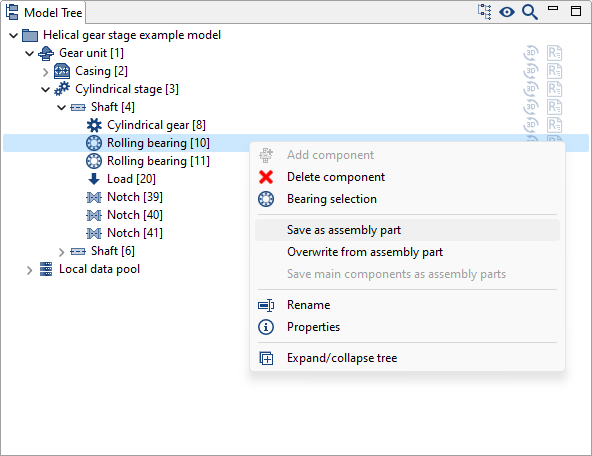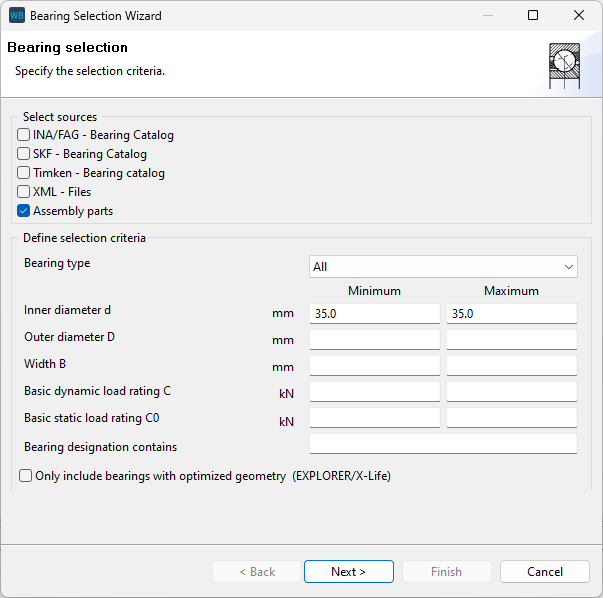Rolling bearings
(Rolling) bearings can be considered in various levels of detail in the FVA-Workbench:
Concept bearings (specification of the bearing stiffness)
Catalog rolling bearings, with specification of the main geometry
Rolling bearings with specification of the internal geometry
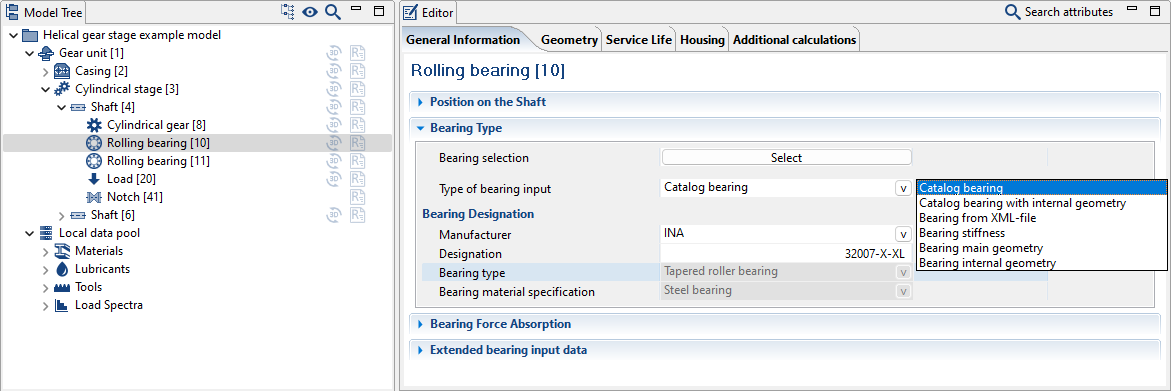
Concept bearings/bearing stiffness
Specification of the "bearing stiffness" makes it possible to define a generalized bearing position in the overall mechanical system. Here, the following parameters apply:
Radial rigidity
Tilting rigidity
Axial rigidity
These can be specified as "ideally rigid," "ideally soft," or user defined. Axial and/or radial clearance can also be specified.
Catalog rolling bearings, with specification of the main geometry
Bearings from the INA/FAG, SKF, and TIMKEN manufacturer catalogs can be selected to simplify the input of rolling bearing data. The associated data on the main geometry, the load ratings, calculation factors, and permissible speeds are automatically loaded from the bearing catalog. The bearings must be manually specified as fixed or floating. Alternatively, this data can also be manually specified (for example, for consideration of other bearing catalogs).
In this modeling variant, the FVA-Workbench estimates the bearing internal geometry required to determine the bearing operating point (bearing stiffness) and additional calculations based on the main geometry and the load ratings. If the internal bearing geometry is known, it should preferably be specified.
Rolling bearings with specification of the internal geometry
The bearing stiffness and the resulting load and pressure distribution as well as the extended lifetime are all significantly influenced by the accuracy of the representation of the contact between the rolling bearings and the bearing rings. The FVA-Workbench provides various options for specifying the required bearing internal geometry.
Rolling bearing internal geometry
In addition to the main bearing geometry, the geometry data for the rolling elements (number, diameter, roller length) and the reference diameter must also be specified.
For ball bearings, the groove radii of the raceways can be determined according to ISO 16281 or specified manually.
For roller bearings, the roller profiling can be determined according to ISO 16281. Alternatively, the profiling of the rollers and the raceways can be specified manually.
Catalog bearings with internal geometry/SKF Bearing Data Service
With the SKF Bearing Data Service, some bearing internal geometry data (in particular, the number and diameter of the rolling elements as well as the reference diameter) can be automatically retrieved from the SKF data server and used for calculations in the FVA-Workbench. This data is then supplemented with internal estimates of additional geometry parameters (such as osculation of the raceways or the effective roller length).
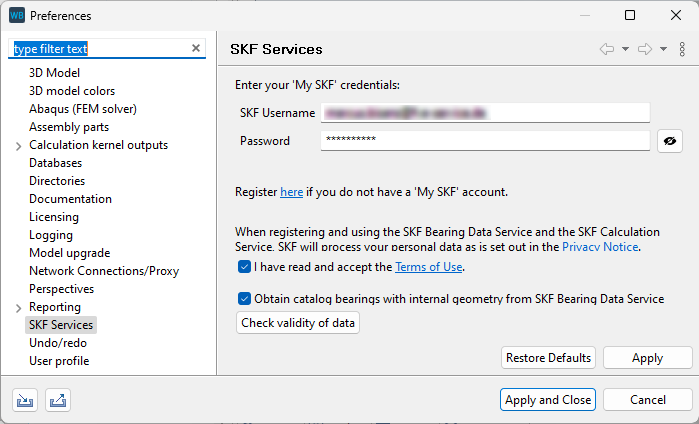
The SKF Bearing Data Service requires an SKF account and an internet connection (see SKF Calculation Service). The SKF Bearing Data Service must also be activated in the settings.

When the SKF Bearing Data Service is activated and an SKF bearing is selected (either using the bearing selection assistant or by specifying the bearing designation in the Editor), a request is automatically sent to the SKF server and the data is imported into the FVA-Workbench model. The "type of bearing input" field is set to "catalog bearing with internal geometry."
The bearing data for existing SKF catalog bearings can also be retrieved via the SKF Bearing Data Service. To do so, the bearing input must be changed to "catalog bearing with internal geometry."

All bearings in an existing model can be converted to "catalog bearing with internal geometry" with a single click.
The "catalog bearing with internal geometry" option is currently only available for SKF bearings.
Bearing data from XML files
Another input option for rolling bearings is importing an XML bearing file. These files could previously be obtained from rolling bearing manufacturers. The characteristic values stored in the XML files include information on both the main rolling bearing geometry and the internal geometry.
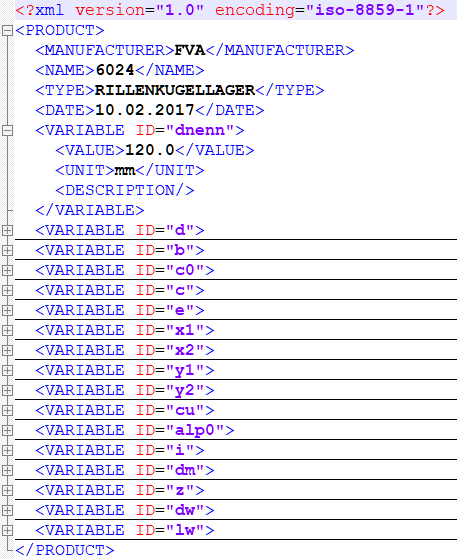
Structure of an XML bearing file
Mounting and preload
It can be specified whether a bearing (or bearing seat) can absorb axial and radial forces. For fixed bearings, the direction of axial force absorption (positive, negative, or both sides) can be specified:
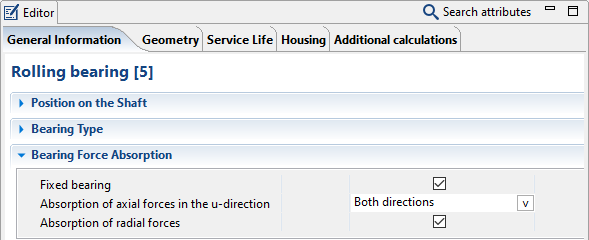
With absorption of axial forces in one direction, an axial clearance of the bearing outer ring seat or an axial preload of the bearing outer ring can also be considered in the overall mechanical system:
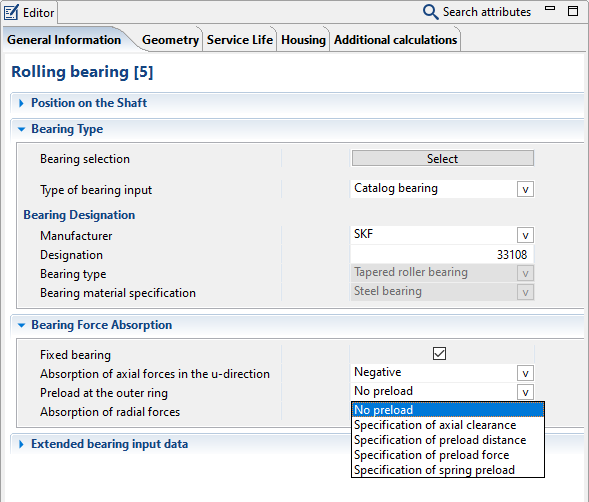
If the preload distance/axial clearance of the outer ring is specified, it is displaced from its nominal position by the specified amount. If the preload force is specified, an additional calculation is performed for the individual bearing to determine the relative displacement between the inner and outer ring as a result of the preload force. This is then used as the preload distance in the overall system. The operating clearance of the bearing is also considered. Please note: the preload force must also be applied to the counter bearing. When specifying a spring preload, the free spring length, the preload distance of the spring, and the spring stiffness can be specified.
Bearings from the Assembly Part Library (user-defined bearing catalog)
Existing rolling bearings in an FVA-Workbench model can be saved to the Assembly Part Library (with all entries) as a user-defined bearing. These bearings can then be accessed via the bearing selection assistant.
